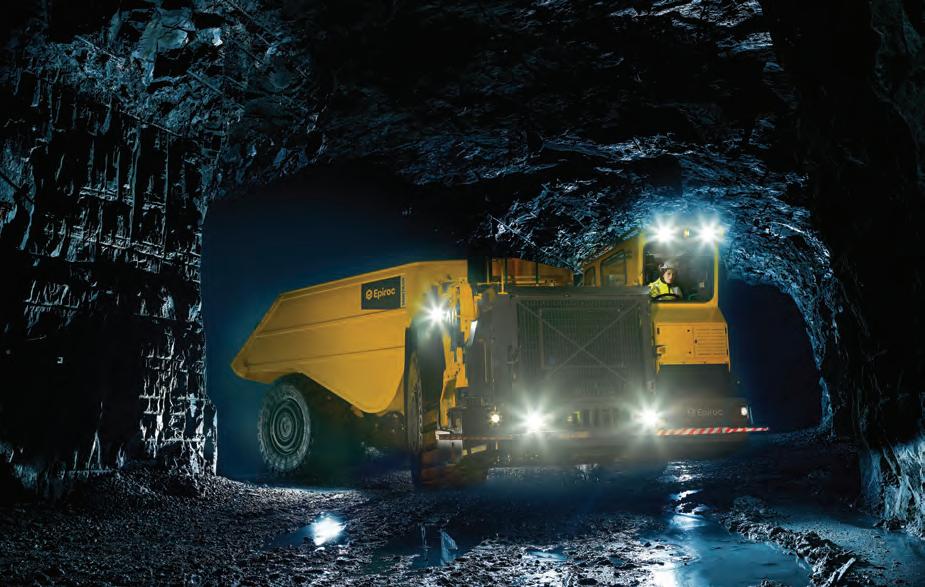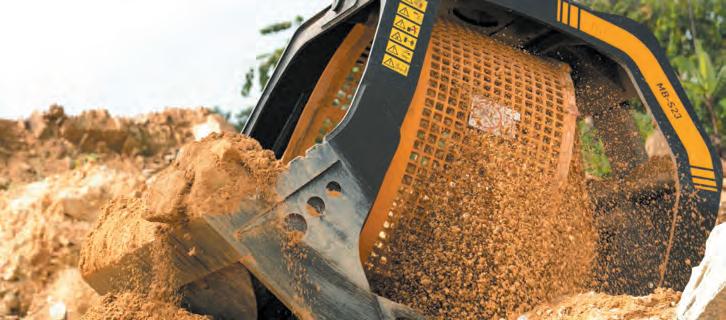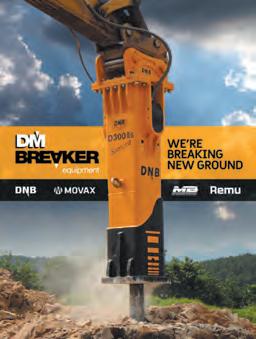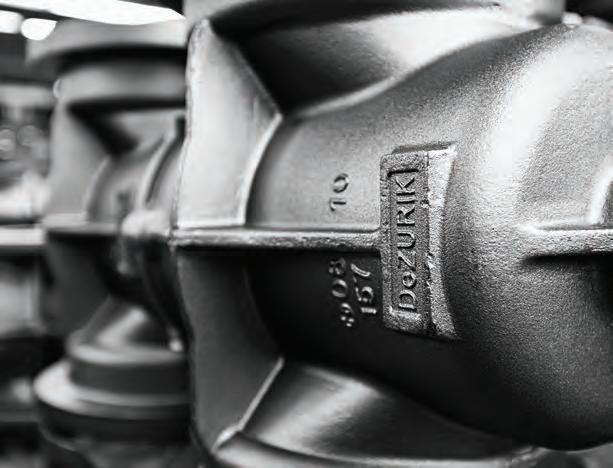
19 minute read
MINING EQUIPMENT
AUTOMATED GROUND SUPPORT A BOLT FROM THE BLUE
A BESPOKE CABLE BOLTING SOLUTION IS SET TO REVOLUTIONISE GROUND SUPPORT FOR UNDERGROUND MINES, WITH THE STAMP OF APPROVAL FROM NONE OTHER THAN NORTHERN STAR RESOURCES.
Rangecon has carved a path for itself in underground project construction since it began in 2014 under the watchful eye of mining engineering John Devereux and his business partner Nic Hicks.
Both men, directors of Rangecon, recognised a hole in the underground mining market for an affordable solution to automate the cable bolting process.
Through a partnership with global mining machinery and technology company Normet, Rangecon developed the Groutmec automated cable bolting machine.
Hicks says it took just 18 months to turn the machine from conception to commercialisation.
“We came to Normet with a requirement and they had the skills, the engineering and the IP to deliver that,” Hicks tells Australian Mining.
“There’s been lots of tweaks along the way, but we have worked closely with them to develop a concept and eventually a commercially viable machine.”
The Groutmec takes Normet’s Charmec machine – originally designed for explosive charging – and reconfigures it to enable automated cable bolting.
This includes the cable bolt installation, tensioning and the grout installation to finish.
“What is normally done in a basket with three workers, we can now complete with two workers thanks to more automation from Normet, as well as a bunch of bespoke parts to facilitate that process,” Hicks says.
The benefits of such innovation are numerous, as described by those at Northern Star Resources who were happy to take on the next step in ground support technology.
The gold miner implemented Groutmec at its Kundana operations in Western Australia, as well as the Mount Charlotte mine at its Kalgoorlie operations.
Northern Star managing director Stuart Tonkin highlights what he’s found to be the biggest advantage of the machine.
“This advanced technology has lifted safety, quality and productivity for this important ground support method,” Tonkin says.
“It eliminates arduous manual handling exposure, while ensuring the consistent quality of grout mix and volumes for reliable strength and design.
“The process has materially reduced time to install, which improves the unit cost and reduces time at the location.”
Safety will always rate highly as a priority for mining executives and the Groutmec vastly reduces the risk of injury by simply removing the number of workers on hand.
Hicks says traditional cable bolting methods can be a common cause of injury where ground support is required, inspiring Rangecon’s latest creation.
Outside of safety, the Groutmec also achieves about double the linear metres of cable bolt achieved by traditional methods.
“We currently have one in production in the Western Australian Goldfields, which consistently achieves 10,000 to 12,000 linear metres of cable bolt per month,” Hicks says.
“From the research we’ve done we haven’t found a comparable machine that would be able to compete with ours.”
As Australian mining battles skills shortages due to COVID-19 restrictions, any machine which reduces the labour required is likely to tick boxes for resources companies.
Hicks says Rangecon is in the process of delivering another Groutmec to North America where similar constraints are being faced.
“Timing is everything. This product has come at the right time as we have a crisis of labour shortage in this space as it reduces labour by one third,” Hicks says.
“You only really need one really experienced operator plus the person up the back who mixes the grout, makes sure there’s enough grout for operation and keeps the rig clean.”
And while the Groutmec reduces cable bolting crews by one third, the benefits to the remaining two workers are clear.
As miners get older, Hicks says they increasingly appreciate any automated machinery that comes their way.
“Operators have definitely embraced it. As a company, we provide all kinds of help that constitute ground support. So, from shotcreting to general underground construction work, we certainly get a lot of interest from senior personnel wanting to operate the Groutmec,” Hicks says.
“From a fatigue perspective, it’s pretty light on and it’s something different for them. A lot of these workers are chasing a new challenge and we’ve had no issue with presenting it as an opportunity to progress a career in underground mining.”
Tonkin agrees, saying his operators at Northern Star continue to show positivity towards the Groutmec, as it takes the load off them and into the ground.
“Specialised skills need focussed specialised operators and Rangecon are ahead of the street in advancing cable bolt installation technology,” Tonkin concludes.
“You can’t unsee success, and the acceptance from operators that have performed this task manually has been key to proving its benefit.” AM
EPIROC FINDS A SOLUTION TO IMPORT DELAYS
WHEN ALKANE RESOURCES’ TOMINGLEY GOLD MINE IN NSW NEEDED NEW MACHINERY TO BETTER SUIT ITS UNDERGROUND OPERATIONS, ORIGINAL EQUIPMENT MANUFACTURER EPIROC DELIVERED.
When a mine site needs new equipment to facilitate a change in operations or an upgrade in equipment, delivery needs to be on schedule to reduce downtime and loss of production.
However, with the majority of original equipment manufacturers (OEMs) based overseas, the recent international border closures have made importing equipment and machinery difficult.
Freight costs have increased and other factors, including union action on some wharfs in Australia, have caused delivery schedules to blow out and cause headaches for operations all over the country.
Tomingley gold mine general manager of operations Jason Hughes says the site needed to upgrade its underground fleet, which included four underground trucks from Epiroc.
“Two were ejectors and two were tipping trucks, and like most people we wanted the trucks yesterday, if possible,” Hughes says.
“Epiroc, rather than building the entire truck over in Europe and shipping them over, were able to get the trucks sent over in kit form and assembled them at their facility in Tasmania.
“They were then able to freight the new trucks directly to site, which allowed us to receive them in a very reasonable time frame considering the circumstances that have been happening around the world.”
Epiroc New South Wales regional manager Alan Sharpe says the MT65 trucks had the right size, speed on grade and manoeuvrability to assist the Tomingley site with its operations.
“Manoeuvrability is a really key factor of the MT65 - its ability to move around in a five to five-anda-half metre drive makes it a leader in those areas in the 60-plus tonne capacity truck,” he says.
“It has great articulation abilities and carrying to abilities to work in the size that Tomingley were operating in, which sets it above the current products that are out there.
“The MT65 also represents quite a significant difference in payload. I worked closely with Jason to give them the confidence that they would be able to take them underground and put them straight to work.”
Epiroc Australia and Asia-Pacific electrified solutions product and sales support lead Brett Kenley says the company shipped three containers per truck (two kit trucks and four trucks in total), which were unloaded in Melbourne.
The company then loaded the chassis, tub, power frame and load frame onto flat beds which were shipped to Burnie in Tasmania.
“We put the power frame and load frame into the workshop in Burnie, then we basically built the trucks from that,” Kenley says.
“We essentially had to put all the components into the truck by following a step-by-step procedure that the company works to over in Sweden.
“We were able to do the build in about five weeks – we normally take two to three weeks to do local modifications but in this case as we built it, we added the local modifications as well and were able to put the trucks together quite quickly.”
The trucks are also equipped with Epiroc’s Certiq technology, which utilises GPS and on-board diagnostics (OBD) to monitor trucks and equipment.
Kenley says this technology is able to record vital information for a mine site.
“It receives all the machine information, so it is able to record speed on grade, fuel burn over its operations, the number of tonnes per dump box, so it basically analyses a shift of work,” Kenley says.
“It shows any faults as well so we are able to actually view those trucks online to see how they are going and so can the customer.
“That helps the client identify their cycle time which is an important piece of information that they can actually monitor.”
Considering the challenges that Epiroc faced in getting the equipment into Australia, Kenley says he is extremely proud of what the company was able to achieve.
Hughes says he was impressed by Epiroc’s commitment to keeping the delivery date of the trucks on schedule.
“To see that kind of assembly here in Australia, at that kind of level, is really pleasing to see,” he says.
“Since the trucks have turned up they have been brilliant – they have far exceeded our expectations.
“Just the coordination from Epiroc was outstanding; nobody on our site had any experience with Epiroc equipment, but they were able to get the trucks on site as well as the training for operators and all the spare parts we needed.

THE MACHINERY WAS ASSEMBLED IN TASMANIA.
MANOEUVRABILITY IS A KEY FACTOR OF THE MT65.

“It all happened very smoothly and working with the Epiroc team has been brilliant.”
Since supplying Tomingley with the trucks, Sharpe says Epiroc is now planning on shipping more equipment to Australia in kit form, including its loaders.
“We will be doing our full underground fleet assembly where required to match the current mining energies for new equipment in Australia,” he says.
“There is still plenty of equipment coming out of the factory, this is just to supplement getting the gear into the country earlier for our clients.
“When you are dealing with highend minerals the miners want the equipment as soon as possible, so it


INNOVATIVE MINING SOLUTIONS

is up to us at Epiroc to do what we can to fast-track delivery.
“It is still very early in the process of bringing in equipment like this, but the opportunities to further grow and enhance that side of the business - and support the factory in these high-demand times - is beneficial for both the company and the clients.”
The Tomingley extension project is expected to extend its gold operations mine life to at least 2031.
“When we first started we used all second-hand gear that was either reconditioned or brought in as-is to get it through that original three-year mine life,” Hughes says.
“Over those years we were able to increase the resource, as well as the reserves, and we were able to increase the mining rate.
“Underground is now mining at just under a million tonnes per annum, the open pit has started again with a small cutback and we have got a whole new deposit down the road.
“Our sites are going really well, we have got a big future ahead of us, so it is an exciting time for Tomingley Gold and Alkane.”
Alkane’s target for Tomingley in the 2021-22 financial year is 55,000 to 60,000 ounces of gold at an all-in sustaining cost (AISC) of $1450 to $1600 per ounce. AM
LASER MEASUREMENT SYSTEMS AND APPLICATION SOFTWARE FOR EFFICIENT MATERIAL HANDLING ¬ Stockpile Management ¬ Truck Load Measurement ¬ Conveyor Belt Monitoring

¬ Bunker Profile Detection ¬ Train Wagon Measurement ¬ Collision Prevention
MORE SOLUTIONS
SWEDISH STEEL A SUPERIOR SOLUTION FOR SCHLAM
BEHIND THE INCREASING PRODUCTION OF AUSTRALIAN MINES ARE RELIABLE EQUIPMENT MANUFACTURERS LIKE SCHLAM. AND BEHIND SCHLAM’S MARKET-LEADING DUMP BODIES IS THE STRENGTH OF SSAB SWEDISH STEEL.
These two companies have been aligned for several years, allowing for faster delivery of products and expertise.
Schlam’s Hercules dump bodies are going from strength to strength, owing to SSAB’s supply of its Hardox wear plate for extreme abrasion resistance.
Schlam sales manager Tom Smith says the foundations of their longstanding relationship was not a signature, but simply reliable steel.
“The relationship with SSAB started because they’ve got a fantastic name in the marketplace,” Smith tells Australian Mining.
“We’ve explored what they can do for us and over time they’ve become our primary supplier. There are no agreements between our companies to formalise this.
“We use them because they have a great product, a great reputation, and they look after us with both collaboration and fantastic technical support.”
The latest addition to the Hardox range is Hardox 500 Tuf, well-suited to all kinds of dump bodies, buckets, containers, and other equipment exposed to heavy wear in the mining and agriculture industries.
Smith says he couldn’t believe how well Hardox 500 Tuf performed.
“The transition from Hardox 450 to 500 Tuf has been an exciting one,” Smith says. “SSAB released it to the market a few years ago, and personally, I was one of the most sceptical of the product on the advertised benefits of Hardox 500 Tuf.
“It didn’t sit right with me; it didn’t seem real. But we’ve tested it extensively at Schlam and it has performed as advertised and, in some applications, it actually exceeded expectations.”
Hardox 500 Tuf builds upon its predecessors in a few key areas – chiefly, material grade.
Smith explains there are three things that matter in the body design for a customer: body weight, floor thickness and material grade.
“We strongly believe we cannot be matched by our competitors, and our steel selection and body design are the reason why,” he says.
“The unique design of Schlam’s Hercules HX dump body allows us to reduce weight whilst keeping the steel thickness where it is required, namely in the floor.”
Simply, if a miner has less weight in the truck body per load, they won’t require as many truck hours, Smith explains.
“We’ve found removing an additional five tonne per load on a typical 240-tonne truck generally saves upwards of $50,000 per year in operating costs,” he says.
“By utilising the Hercules, you can potentially upgrade your floor from 20 millimetres (mm) quenched and tempered 450 to 25mm Hardox 500 Tuf without increasing body weight, meaning you increase service life and reduce the carbon impact of your dump body without sacrificing payload.”
While the end user receives major benefits from the use of Hardox 500 Tuf, manufacturers like Schlam are also largely improved by its use.
SSAB area sales manager for Australia and New Zealand, Matthew Spiteri, describes how Hardox 500 Tuf makes Schlam’s life easier.
“The Hardox 500 Tuf workshop properties are very close to Hardox 450 grade, so Schlam doesn’t have to change welding, pressing and cutting procedures, which are vital in an efficient production environment,” Spiteri says.
“Not only that, but our plate compared to other quenched and tempered manufacturers has tighter welding tolerances to benefit end users.
“This means the pre-heat thickness is single plate, reducing the time of pre-heating for Schlam which can improve costs on gas, time and production.”
These efficiencies are equally beneficial to the end user, manufacturers and the environment, as it is becoming increasingly important for all parties within the mining industry.
“We find it to be the next step for the likes of Schlam as it not only improves production, but it improves emissions for increasingly eco-minded mining companies due to the reduced body weight,” Spiteri says.
Also in sustainable steel production, SSAB developed the first fossil-free steel in August 2021 and is continuing to partner with companies globally for its supply over the coming 12 to 18 months.
Spiteri says SSAB achieved its green steel goals far sooner than it hoped.
“By 2026, we aim to have it manufactured quite freely with good, designated partners around the world,” he says.
Without wanting to give too much away, as is the key for any industry leading business, Spiteri says Hardox 500 Tuf wasn’t the last we would be hearing from SSAB.
“We’re always looking to improve our products and so there will be more products that have the Tuf aspect to them in the future,” he concludes. AM

HARDOX 500 TUF CAN REDUCE WEIGHT OR INCREASE SERVICE LIFE.
WE’RE BREAKING NEW GROUND

MB CRUSHER BUCKETS
MB Crushing Technology has revolutionised the concept of Crushing and Screening systems. With more than 60 years of experience in the excavation, road work, quarry, and demolition sectors, MB Crushing are at the forefront of research and technology. Crusher and screening buckets allow operators and contractors to reprocess materials in situ, helping reduce the load on the environment by making useful by-products of otherwise low value raw feed, which may add significantly to their profitability.


REMU RECYCLING BUCKETS
Remu Screening Buckets are an ideal recycling solution. A multifunctional tool for padding, mixing, separating and crushing. These buckets are used in situ for council recycling collections, greenwaste, bio waste, manure, builders rubble, gyprock, landscaping, asphalt millings or shoreline cleanups. Whether you are a contractor, roadbuilder, pipeliner, landscaper or in mining, Remu has several options to choose from. Interchangeable sized rotors enable various sized products to suit your needs.
MB SCREENING BUCKETS
Simple to use & install, these buckets are equipped with interchangeable screens available in different sizes. A hydraulic intermittent system allows it to be used with wet and dry materials. It has the advantage of onsite screening of various materials and are used for both before and after the crushing stage giving the owner the ability to manage materials best suited for the job. The range of Crusher and screening buckets covers excavators, skid steers and loader from 3 ton through to 100 ton.
QUALITY PRODUCTS, ADVICE & SERVICE
Our success is underpinned by the cornerstones of quality products, professional advice and superior service. Contact DM Breaker Equipment today to find out how we can help you with your machinery equipment and attachment needs.
25 Valencia Way I Maddington I WA I 6109 e sales@dmbreaker.com t (08) 9452 1112 f (08) 9452 1113 dmbreaker.com.au
DOWNLOAD OUR BROCHURE TODAY!

THE VALUE OF VALVES FROM COAST TO COAST
THE VALVE COMPANY HAS GROWN FROM STRENGTH TO STRENGTH SINCE THE PANDEMIC BEGAN IN EARLY 2020, OPENING A NEW BRANCH IN BRISBANE THAT IT WILL USE AS A SPRINGBOARD FOR EXPANSION ALONG AUSTRALIA’S EAST COAST.
IAN HAWKINS AND TVC CAN’T WAIT TO VISIT CLIENTS ONCE MORE.

As Australia’s sole distributor of DeZURIK valve products, The Valve Company (TVC) recognises the importance of equally servicing the many mining hubs scattered across the country.
Having established itself in Western Australia in 1994, TVC took the next step in Queensland during 2020 with a view to benefit a wider range of mining customers with quality valve products.
Such is the customer-focussed ethos of TVC, a new branch was hardly about enhancing the company name.
Rather, it enabled TVC to take on the renowned DeZURIK name in a whole new way.
TVC business development manager Ian Hawkins is one of the inaugural staffers at the new Murarrie facility outside Brisbane. He explains TVC’s approach in taking on the East Coast.
“We bought the previous East Coast distributor’s inventory, we bought all of DeZURIK Australia’s inventory, we then bought another $1 million worth of additional inventory, plus we still have all of our WA inventory,” Hawkins tells Australian Mining.
“Something I love about TVC is that the leadership team recognises we are a stockist, and they back up our commitment to the brands we serve by holding inventory.”
The need for extra inventory heightened during the onset of the pandemic as supply chains were universally disrupted and lead times suffered.
Despite this, Hawkins says the past couple of years have been transformative for TVC.
“Our inventory has helped us grow – we had a phenomenal first year in the 2021 financial year – and we expect 2022 to come up even better,” Hawkins says.
“The first goal we kicked was a halfa-million-dollar order last financial year with the M1 upgrade project on the Gold Coast.”
Another benefit of having significant inventory on hand is the ability for customers to trial DeZURIK products.
Hawkins says this allows customers to understand the value of what they might receive should they opt to work with TVC.
“These trials will depend on the client,” Hawkins says. “Normally, we’d mock up a purchase order for them to understand how the process would work, they use it for about six months, and if they’re happy we can lock in an order.”
It’s this customer-friendly take that allows TVC to build strong relationships, which in turn enable better use of DeZURIK products.
Hawkins says there’s nothing better than visiting a customer’s operation to discuss their valve application, answering any questions they might have.
“In mid-2021 we made a lot of inroads with a client in Mount Isa where our relationship basically allowed us to walk up and tour their site to investigate where we can optimise their equipment,” Hawkins says.
“The number-one goal of selling this equipment is being able to help people, make their lives better in some way, and maybe teach them something along the way.
“We’re frequently identifying problems in customers’ applications. We don’t always get the sale but we’re always looking to help out for the betterment of the client.”
Examples of DeZURIK valves include its flagship KGC-ES Knife Gate, which sets the brand apart from its competitors.
With a 100 per cent port size and a design built for longevity in a hardwearing mining industry, Hawkins says the KGC-ES represents why he loves his job.
“What I really like about being a valve salesman is identifying the unique features and benefits of each individual brand,” he says.
“This isn’t just another valve which has copied all the features of the next brand, but it’s got its own real benefits that set it apart.”
TVC’s other highlights include DeZURIK’s KUL non-discharge urethane-lined slurry Knife Gate valve, or the traditional sleeved slurry Knife Gate. Both of which are customer favourites, accoding to Hawkins.
“We have sleeved slurry Knife Gate stocked up to 24 inches,” he says. “Sometimes when we mention this to customers, I have to return to the office to take a picture because they won’t believe me.”
Looking forward, TVC is eager to build upon the growth enabled by its new Brisbane facility. Hawkins says he’s excited to get back on site where he and TVC do their best work.
“The first thing we’re looking forward to in 2022 is regional visits across eastern Australia and especially in mining-heavy areas. We will also be looking to grow our sales team to ensure all of eastern Australia is well looked after,” Hawkins concludes. AM

THE VALVE COMPANY HAS BECOME SYNONYMOUS WITH DEZURIK VALVES.










